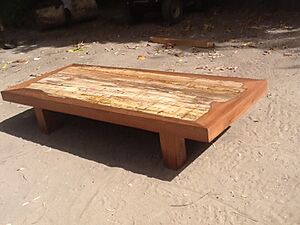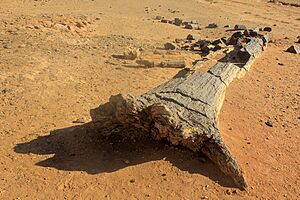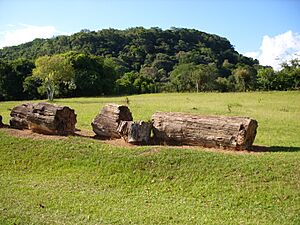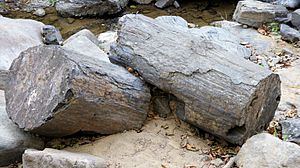Petrified wood facts for kids
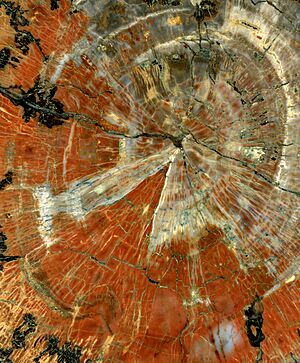
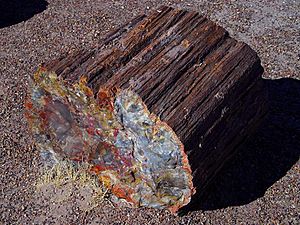
Petrified wood is a special kind of fossil. It's wood that has turned into stone over a very long time. The word "petrified" comes from an Ancient Greek word meaning 'rock' or 'stone'. So, petrified wood literally means 'wood turned into stone'.
This happens when a tree or plant gets buried underground. Minerals from water then replace the original wood. This process is called petrifaction. The plant's cells are slowly filled and replaced by minerals, mostly silica. This is the same mineral found in quartz.
Unlike other plant fossils, which might just be flat prints, petrified wood keeps its original 3D shape. You can often still see the tree's rings and bark!
The petrifaction process usually happens underground. Wood gets buried in water or volcanic ash. Being underwater means there's less oxygen. This stops bacteria and fungi from breaking down the wood. Water full of minerals then flows through the buried wood. These minerals slowly fill up the empty spaces inside the wood's cells. Over time, the wood's original material is replaced by these minerals. This turns the wood into stone.
When a whole forest turns into stone this way, it's called a petrified forest.
Contents
How Petrified Wood Forms
Petrified wood forms when plant stems are buried in wet dirt. This dirt must be full of dissolved minerals. If there isn't much oxygen, the wood decays very slowly. This gives minerals time to replace the wood's cell walls. They also fill any empty spaces inside the wood.
Wood is mostly made of two main things: cellulose and lignin. Cellulose gives wood its strength. Lignin helps to make wood waterproof and strong.
Normally, tiny living things like bacteria break down dead wood very quickly. But if wood is buried fast, especially in mud from volcanic ash, it can be saved. The lack of oxygen stops these tiny living things. Then, minerals can start to turn the wood into stone.
About 40 different minerals have been found in petrified wood. But silica minerals are the most common. Silica attaches to the cellulose in the wood's cell walls. It creates a kind of mold. Then, more silica replaces the cellulose as it breaks down. This is why the tiny details of the wood cells are often perfectly preserved.
Over a very long time, almost all the original wood material is gone. Only about 10% of the original wood remains. The rest is nearly pure silica. The colors you see in petrified wood come from tiny amounts of other metals. For example, iron can make it red, brown, or yellow. Chromium can make it bright green.
Sometimes, wood can turn to stone very quickly. This happens in hot springs that are rich in silica. These places are important for scientists. They can show how early land plants evolved.
Wood can also be petrified by other minerals like calcite. This often happens in coal beds. Petrified wood that is not made of silica can sometimes collect heavy metals. These include uranium or germanium.
Making Petrified Wood
Scientists have tried to make petrified wood themselves. They do this to understand how it forms naturally. They also hope to use it as a new type of ceramic material.
What Petrified Wood is Used For
Petrified wood is sometimes used to make jewelry. But it's mostly used for decorations. You might see it as bookends, table tops, or other pretty objects.
Long ago, some ancient people built houses using petrified wood. One example is the Agate House Pueblo in Petrified Forest National Park. Some people also believe petrified wood has special healing powers.
Where to Find Petrified Wood
Petrified wood is found all over the world. It can be found in layers of rock that are very old. Some pieces are from about 390 million years ago. That's when woody plants first appeared on land!
Petrified "forests" are usually one of two types:
- Whole forests buried by volcanic eruptions. Here, the tree trunks often still stand upright.
- Piles of wood that drifted in rivers. These then got buried by mud.
Volcanic ash is especially good for preserving wood. This is because it releases a lot of silica as it breaks down. So, if you find petrified wood, it often means there was volcanic ash nearby.
Here are some places where you can find a lot of petrified trees:
Africa
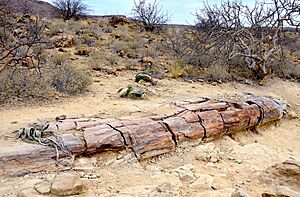
- Egypt – There are petrified forests near Cairo and in the Farafra oasis.
- Libya – The Great Sand Sea has huge areas with petrified trunks and branches.
- Madagascar – Found on the Northwest Coast.
- Namibia – The petrified forest of Damaraland.
- Sudan – A petrified forest north of El-Kurru.
Asia
- China – In the Junggar Basin of Xinjiang.
- India – Famous sites include the National Fossil Wood Park, Tiruvakkarai (20 million years old) and the Akal Wood Fossil Park (180 million years old).
- Japan – A fossilized forest is kept at the Sendai City Tomizawa Site Museum.
- Indonesia – Petrified wood is found in Banten and parts of Mount Halimun Salak National Park.
- Israel – Examples are found in the HaMakhtesh HaGadol in the Negev desert.
- Pakistan – In the Khirthar National Park in Sindh.
- Saudi Arabia – A petrified forest north of Riyadh.
- Thailand – The Bantak Petrified Forest Park has the longest petrified log in the world. It measures almost 70 meters!
Oceania
- Australia – Has deposits of petrified wood. Chinchilla, Queensland is known for its 'Chinchilla Red' petrified wood.
- New Zealand:
* Curio Bay has many examples of petrified wood. * Fossil Forest, Takapuna, Auckland. * Titahi Bay Beach, Porirua.
Europe
- Belgium – Geosite Goudberg near Hoegaarden.
- Czech Republic – Nová Paka is a famous place for rocks from the Permian–Carboniferous periods.
- France – A petrified forest in the village of Champclauson.
- Georgia – Goderdzi Petrified Forest Natural Monument.
- Germany – The museum in Chemnitz has a collection of petrified trees. They were found in the town in 1737.
- Greece – The Petrified forest of Lesbos is possibly the largest petrified forest. It covers over 150 square kilometers. It was made a National Monument in 1985. You can find large, upright trunks there. Some are up to 22 meters long.
- Italy:
* The Foresta fossile di Dunarobba is near Avigliano Umbro. * The Foresta pietrificata di Zuri – Soddì is near Soddì in Sardinia.
- Norway – A fossilized tropical forest in Svalbard.
- Ukraine – Petrified araucaria trunks near Druzhkivka.
- United Kingdom:
* Fossil Grove, Glasgow, Scotland. * Fossil Forest, Dorset, England.
North America
- Canada – Found in the badlands of southern Alberta. Petrified wood is the official stone of Alberta. Axel Heiberg Island in Nunavut has a large petrified forest.
- United States:
* Petrified Wood Park in Lemmon, South Dakota. * Ginkgo Petrified Forest State Park in Washington state. * Petrified Forest National Park in Arizona. * Petrified Forest in California. * Mississippi Petrified Forest in Flora, Mississippi. * Florissant Fossil Beds National Monument in Florissant, Colorado. * Yellowstone Petrified Forest in Yellowstone National Park, Wyoming. * Theodore Roosevelt National Park in North Dakota. * Gilboa Fossil Forest in New York. * Escalante Petrified Forest State Park in Utah. * Valley of Fire State Park in Nevada. * Bisti/De-Na-Zin Wilderness in New Mexico. * Prince William Forest Park in Virginia.
South America
- Argentina – The Sarmiento Petrified Forest and Jaramillo Petrified Forest in Santa Cruz Province. Some trees are more than 3 meters wide and 30 meters long!
- Brazil:
* The geopark of Paleorrota has many petrified trees. * The Monumento Natural das Árvores Fossilizadas in Tocantins. * The Floresta Fóssil de Teresina near Rio Poti, Piauí. These are about 280–270 million years old.
- Ecuador – Puyango Petrified Forest is one of the largest collections of petrified wood in the world.
See also
 In Spanish: Bosque petrificado para niños
In Spanish: Bosque petrificado para niños
- Amber
- Amethyst Mountain
- Araucarioxylon arizonicum
- Fossil wood
- Jet (gemstone)
- Palmoxylon (petrified palmwood)
- Submerged forest
- Wood opal





